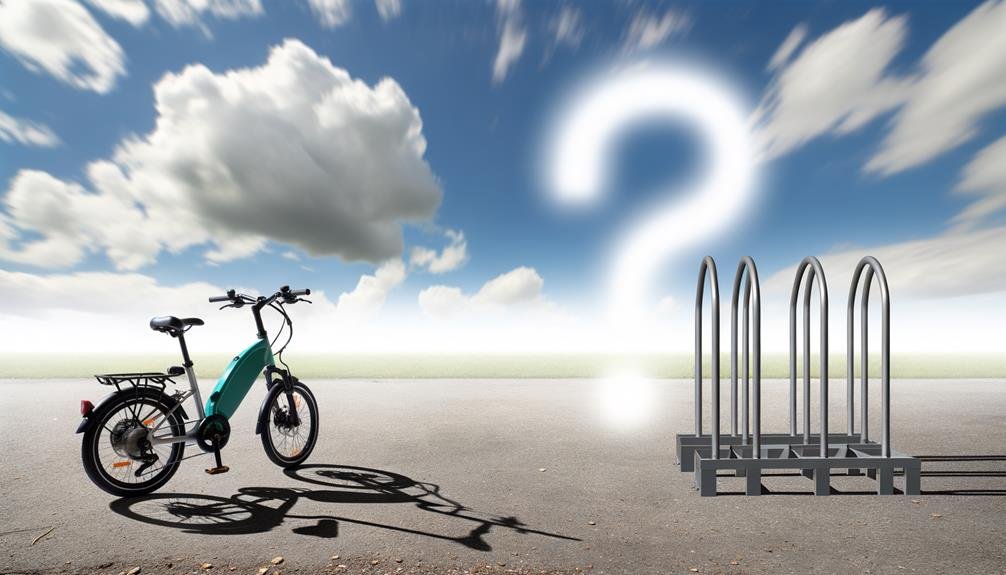Charles Miller is a veteran bike enthusiast with over 12 years of experience dealing with bikes as a mechanic. Despite immense love and expertise for...
Just as a ship needs the right sail to navigate turbulent waters, we need the right ebike to conquer off-road trails.
The world of ebikes is vast, with each model offering a unique combination of features that can make or break our off-road experience. From battery capacity and range to weight capacity, speed options, and suspension type, there's a lot to consider when choosing the perfect off-road ebike.
But how do we know which one is the best fit for our adventurous needs? Join us as we embark on a journey to explore the rugged landscape of off-road ebikes, and you might just find the perfect ride for your next outdoor adventure.
- Key Takeaways
- Understanding Off-Road Ebikes
- Evaluating Battery Capacity
- Importance of Range in Off-Road Ebikes
- Weight Capacity Considerations
- Exploring Different Speed Options
- Different Types of Off-Road Ebikes
- Suspension Type and Its Impact
- Assessing Brake Types and Warranty
- Frequently Asked Questions
- Conclusion
Key Takeaways
- Off-road ebikes are designed for diverse terrains and offer features like powerful motors, fat tires, and increased weight capacity.
- Battery capacity directly impacts the range of off-road ebikes, so considering battery capacity and range is important.
- Weight capacity considerations should be taken into account to ensure stability and safety while riding off-road.
- Different speed options, including pedal-assist and throttle control, can enhance the riding experience, and adjustable speeds offer flexibility based on personal preference.
Understanding Off-Road Ebikes
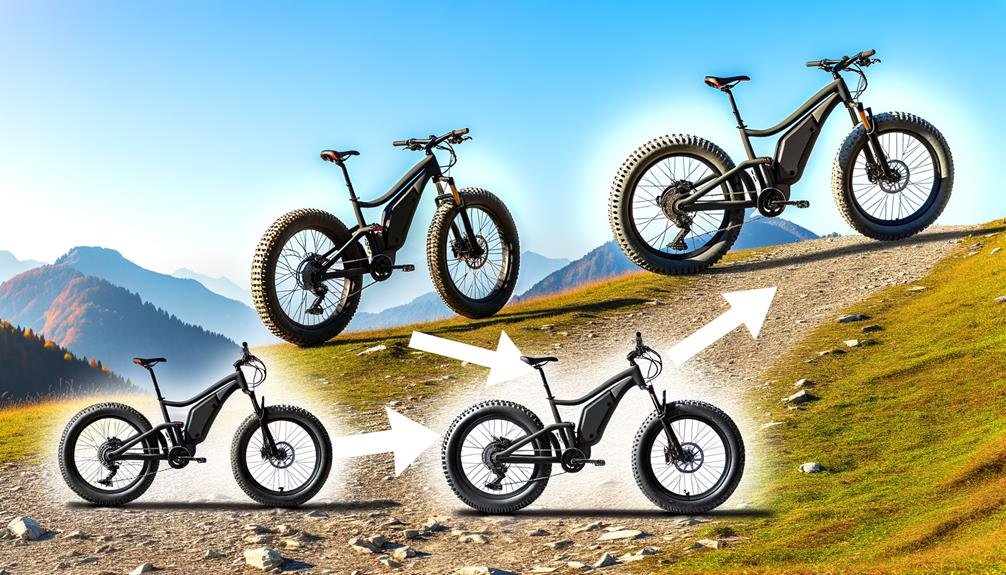
When it comes to understanding off-road e-bikes, it's essential to know that these all-terrain machines are meticulously crafted to conquer diverse terrains like dirt, snow, and mud. They achieve this with their powerful motors, fat tires for superior traction, and increased weight capacity for handling heavier loads. We can enjoy the best off-road experiences with these high-performing bikes.
In our exploration of off-road electric bikes, we've identified essential factors to consider. These include the motor power, battery capacity, frame material, suspension type, and tire size. Each of these plays a crucial role in the bike's performance and our overall off-road experience.
We're not limited in our choices. There are various types of all-terrain e-bikes, including hardtail, full suspension, fat tire, electric mountain bikes (eMTBs), and folding e-bikes. Each type offers unique benefits, catering to our individual off-road riding preferences and requirements.
Thanks to popular brands like Trek, Specialized, Giant, Haibike, and Rad Power Bikes, we've got a wide range of off-road e-bikes featuring advanced technologies at our fingertips.
Understanding off-road ebikes helps us find our perfect match in this adventurous world.
Evaluating Battery Capacity
Having explored the various types of off-road e-bikes and their unique features, let's now focus on a key element that significantly impacts these bikes' performance – the battery capacity.
Evaluating battery capacity is essential when choosing an electric off-road bike, as it directly affects the bike's range and power delivery, both of which are crucial for tackling challenging terrains.
A larger battery capacity allows for longer rides, providing peace of mind, especially when venturing into remote areas. However, it's important to note whether the stated range is for pure electric mode or pedal-assisted mode, as this can significantly affect your ride experience.
Beyond range and power, understanding the battery's recharge time is also crucial. No one wants to be left waiting for hours for their off-road e-bike to recharge in the middle of an exciting adventure. Additionally, considering any warranty coverage for the battery is paramount to ensure its longevity and consistent performance.
Importance of Range in Off-Road Ebikes
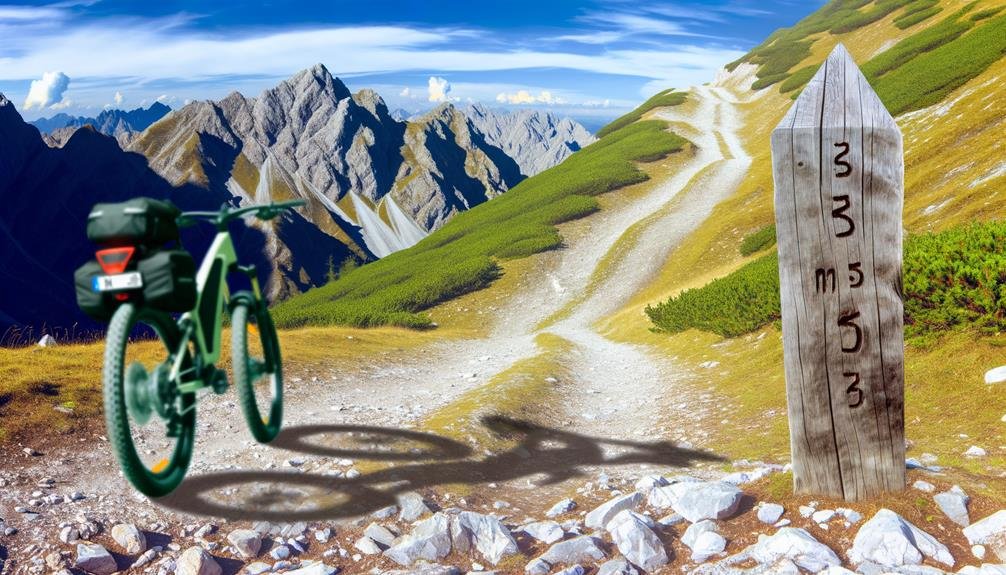
The range of an off-road ebike isn't just a number; it's the heart of every thrilling ride, dictating how far we can venture into uncharted terrains without worrying about running out of power. The importance of range in off-road ebikes can't be overstated; it's our ticket to endless adventure, enabling us to cover more ground and conquer new trails.
| Off-Road Bikes | Battery Capacity | Range |
|---|---|---|
| Bike A | 500Wh | 60 miles |
| Bike B | 700Wh | 80 miles |
| Bike C | 900Wh | 100 miles |
| Bike D | 1300Wh | 140 miles |
| Bike E | 1500Wh | 160 miles |
This table illustrates how battery capacity impacts the range of various off-road bikes. We can see that as the battery capacity increases, so does the range, allowing for longer, more exciting off-road expeditions. Whether you're a seasoned mountain bike rider or new to the off-road scene, choosing an ebike with a significant range will ensure you're not left stranded in the middle of nowhere, fueling your outdoor adventures with reliable power.
Weight Capacity Considerations
In our quest for the perfect off-road e-bike, we mustn't overlook the bike's weight capacity – a pivotal factor that ensures the bike can comfortably support both the rider and any additional gear or cargo. With this factor in mind, weight capacity considerations become critical in our selection process.
A higher weight capacity, often found in bikes with a robust aluminum frame, allows us to carry heavier loads, ensuring better stability and safety on off-road terrain. It's crucial to check the maximum weight capacity of the e-bike to align with our body weight and the items we plan to carry during our off-road adventures.
Exceeding the weight capacity can affect the e-bike's performance and durability, so adhering to the manufacturer's guidelines is essential. Bikes with a strong rear suspension can also handle greater weight, providing a smoother ride on rough terrain.
Weight capacity shouldn't be considered in isolation. It must be balanced with the bike's battery capacity and motor power to ensure an efficient off-road riding experience. Therefore, when hunting for the perfect off-road e-bike, weight capacity is an important consideration to keep in mind.
Exploring Different Speed Options
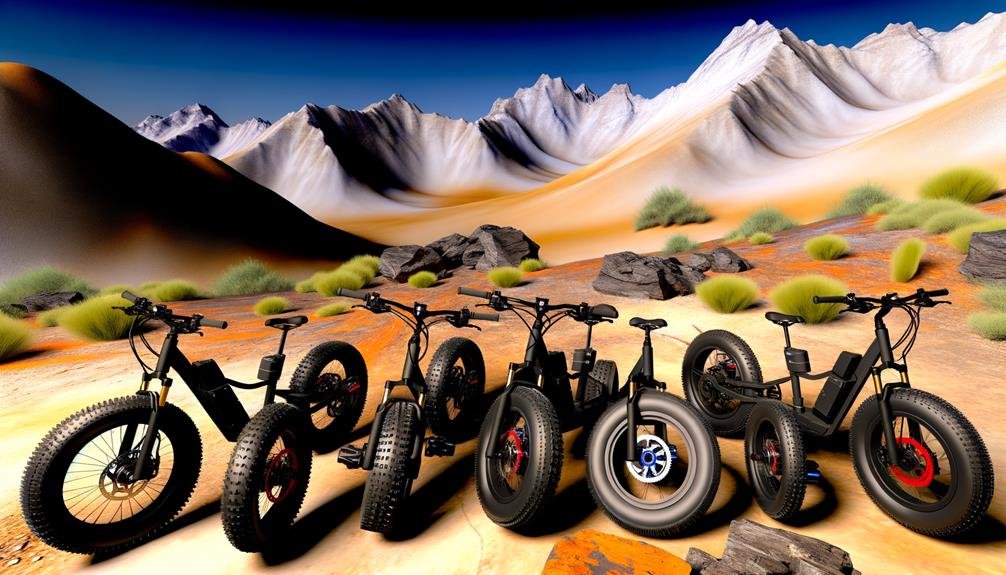
Let's now turn our attention to the speed options available on off-road ebikes. In understanding ebike speed limits, we'll examine features like pedal-assist and throttle control, which can greatly impact the velocity of your off-road ebike and your overall riding experience.
The ability to control speed gives riders the freedom to tailor their rides to their preferences and the demands of different terrains.
Understanding Ebike Speed Limits
Diving into the world of ebikes, we quickly find that understanding ebike speed limits is crucial. These limits, typically ranging from 15 to 28 mph, are influenced primarily by the electric motor power and regional regulations.
- Most ebikes are limited to a top speed of 20 mph, to qualify as electric bicycles in the US, allowing us to enjoy the freedom of bike lanes and paths.
- Higher-performance models, known as speed pedelecs, can reach up to 28 mph, but may require licensing and registration, just like mopeds or motorcycles.
- Ebikes often come with options to adjust the maximum speed, offering flexibility for various riding conditions and legal requirements.
- Understanding these speed limits and options is key to finding an ebike that aligns with both your personal riding preferences and the law.
Off-road Ebike Velocity
As we've explored the speed limits of ebikes, it's important to note that off-road ebikes offer a different array of velocity options, designed to tackle diverse terrains and enhance your adventure. The off-road ebike velocity can be altered depending on the terrain and rider's preference, increasing the thrill of the ride. Features like hydraulic disc brakes provide secure stopping, while front suspension systems ensure a smoother ride on uneven terrains.
Here's a comparison table to illustrate:
| Feature | Benefit |
|---|---|
| Off-road ebike velocity | Adjustable speeds for diverse terrains |
| Hydraulic disc brakes | Secure stopping ability |
| Front suspension | Smooth ride on uneven terrains |
| Powerful motor | Extra assistance on challenging surfaces |
| Fat tires | Better traction and stability |
Speed Control in Ebikes
Navigating through the various speed control options in e-bikes, we find a diverse range including throttle-only, pedal-assist, or a combination of both, which gives riders the flexibility to tailor their power assistance based on personal preference.
- Throttle-only ebikes allow for immediate power, handy when quick acceleration is necessary.
- Pedal-assist ebikes offer five pedal assist levels, providing a more intuitive ride by matching the motor's power to your pedaling.
- A mix of throttle and pedal-assist combines the advantages of both, offering versatility in various terrains.
- Hydraulic brakes enhance speed control in ebikes, ensuring a safe stop regardless of speed.
Understanding these options helps choose an ebike that aligns with your riding style, making the off-road experience more personalized and efficient.
Different Types of Off-Road Ebikes
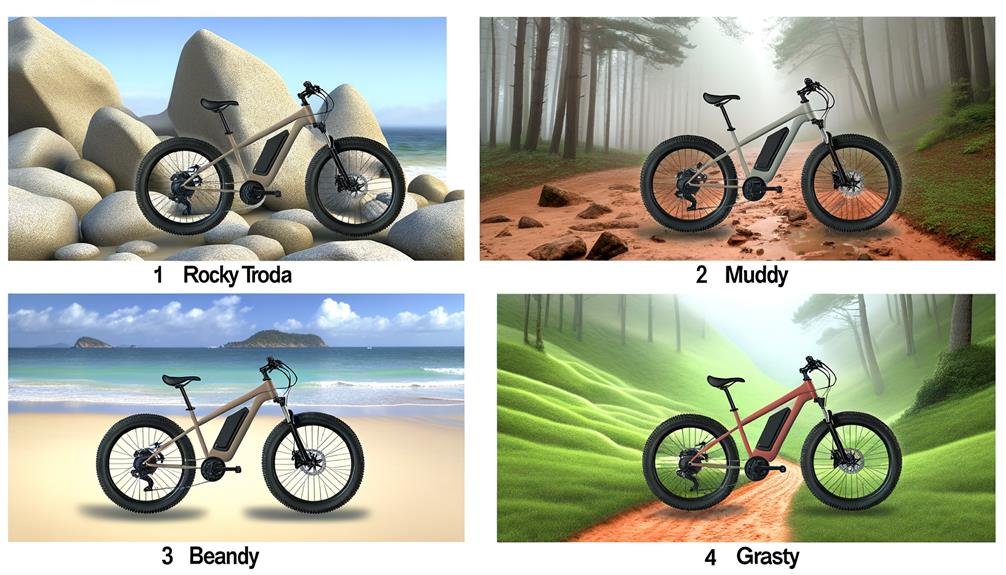
Let's explore the diverse range of off-road ebikes available today.
We'll start by examining the unique features of mountain ebikes.
Move on to the undeniable advantages of fat tire ebikes.
Finally, we'll consider the versatility of hybrid ebikes for off-road use.
This analysis will help us understand how their distinct characteristics can enhance the off-road biking experience.
Mountain Ebikes Features
Diving into the world of mountain e-bikes, we find a variety of types including hardtail, full suspension, fat tire, electric mountain bikes (eMTBs), and folding e-bikes, each uniquely designed to tackle different terrains with features like powerful motors, fat tires for improved traction, and advanced suspension systems for better shock absorption.
Here are some key mountain ebikes features to consider when seeking the perfect off-road companion:
- Motor Power: Higher power offers better assistance on steep terrains.
- Battery Capacity: A larger capacity ensures longer rides off the beaten path.
- Suspension Type: Full suspension provides superior shock absorption on bumpy trails.
- Tire Size: Fat tires offer improved traction on slippery or uneven surfaces.
Understanding these features helps us choose the right e-bike for our off-road adventures.
Fat Tire Ebikes Advantages
Turning our attention to fat tire e-bikes, we find they offer significant advantages for off-road enthusiasts. These bikes have larger tire sizes, ranging from 3.8 to 5 inches, which provide excellent stability and grip on challenging terrains like snow or mud. This means a smooth and comfortable ride that you can trust.
In addition to their tire size, fat tire e-bikes also have robust motors that ensure riders can conquer steep inclines. This makes them perfect for off-road adventures where the terrain may be more challenging.
Furthermore, fat tire e-bikes typically incorporate hydraulic brakes, which offer greater stopping power. This is essential for safe off-road cycling where quick stops may be necessary.
Another advantage of fat tire e-bikes is their higher weight capacity. These bikes are designed to carry heavier loads with ease, making them ideal for those who need to transport gear or equipment while off-roading.
In essence, fat tire e-bikes are a fantastic choice for off-road adventuring. Their larger tire size, robust motors, superior suspension systems, and higher weight capacity make them well-suited for tackling challenging terrains and carrying heavier loads.
Hybrid Ebikes for Off-Road
Venturing into the realm of hybrid e-bikes for off-road use, we find a diverse array of options, including all-terrain, hardtail, full suspension, fat tire, electric mountain, and folding e-bikes, each engineered to meet specific needs and preferences for tackling varied terrains.
When choosing the best hybrid ebikes for off-road, consider these four key factors:
- *Motor Power:* Higher power equates to more assistance on steep inclines.
- *Battery Capacity:* Longer rides require a larger battery capacity.
- *Frame Material:* Lighter materials like aluminum offer better maneuverability.
- *Suspension Type and Tire Size:* These impact comfort and traction on different terrains.
These insights will guide you in identifying the best off-road e-bike that fits your adventurous spirit while ensuring a comfortable and thrilling ride.
Suspension Type and Its Impact
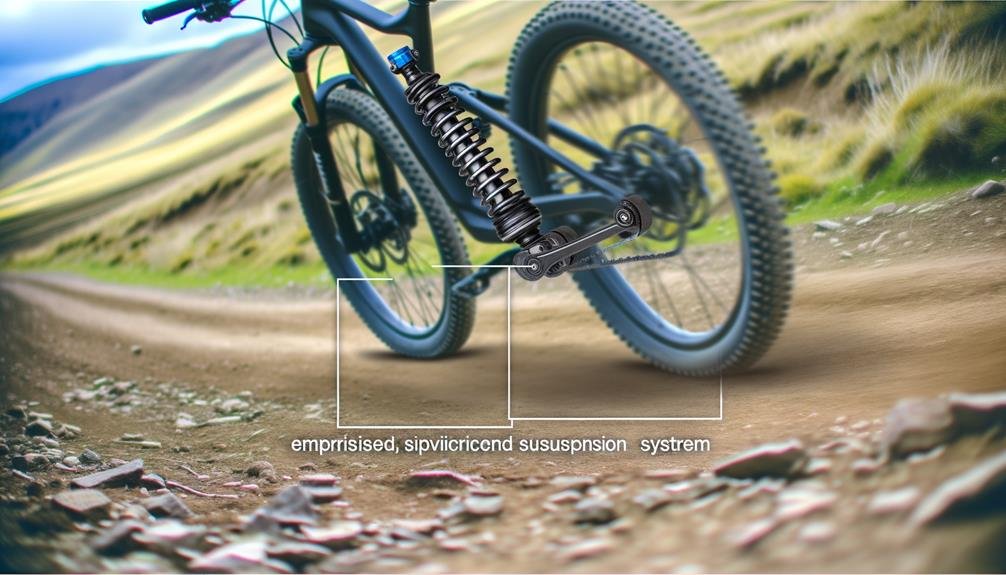
When it comes to off-road ebikes, the suspension system plays a vital role in absorbing shocks and navigating rough terrains with ease and control. The suspension type, be it dual, front, air, or coil suspension, significantly affects your bike's off-road performance.
Dual-suspension setups are a favorite among off-road enthusiasts. These systems, providing suspension on both front and rear wheels, offer enhanced comfort and control on challenging terrains. They're perfect for those lengthy, adventurous trails where every bump can be felt.
On the other hand, front suspension setups offer a more cost-effective alternative while still providing a solid level of shock absorption. Although less comfortable on rough terrains compared to dual-suspension, they're a great choice for off-road beginners or those on a budget.
Air and coil suspensions, meanwhile, provide a different set of benefits. They allow riders to fine-tune their bike's suspension according to specific off-road conditions and personal riding preferences, thus enhancing performance.
Ultimately, selecting the right suspension type is crucial to truly relish the off-road experience. It's not just about speed and power, but also about achieving optimal comfort, control, and performance during your off-road journey.
Assessing Brake Types and Warranty
Delving into the mechanics of off-road e-bikes, it's essential to evaluate the brake types and warranty – two significant factors that contribute to both safety and the longevity of your investment.
We'll break down the importance of brakes, specifically hydraulic systems, and the peace of mind a solid warranty can bring.
- When assessing brake types, hydraulic brakes are a top contender. They use hydraulic fluid for improved comfort and efficiency, and importantly, they've lower brake fade. This is especially critical when navigating challenging off-road conditions.
- Pairing disc brakes with hydraulic systems further enhances braking performance. This combination provides the stopping power necessary for any terrain.
- The warranty is no less important. Several brands offer warranties ranging from 12 to 18 months. These provide coverage for repairs and replacements of damaged parts.
- Finally, consider a lockable front suspension. This feature increases comfort and control, ensuring a smooth ride even on rough terrain.
It's important to belong to the group of informed buyers who make decisions based on a thorough understanding of mechanics. By evaluating brake systems and warranties, you're taking your off-road e-bike experience to the next level.
Frequently Asked Questions
Are Electric Bikes Good for Off-Road?
We believe electric bikes are excellent for off-road use. Their durability, terrain adaptability, and off-road safety features make them a reliable choice. We're confident in their ability to tackle any off-road adventure you're planning.
What Is the Best Electric Bike for Hunting?
We believe the QuietKat Apex is best for hunting due to its hunting gear integration, low noise levels, and terrain adaptability features. It's robust yet silent, perfect for navigating off-road terrains without disturbing wildlife.
What Is the Difference Between a Class 2 and Class 3 Ebike?
We're comparing Class 2 and Class 3 ebikes. The main differences lie in speed limits and regulatory implications. Class 3's faster, but has stricter regulations. Class 2's slower, but has fewer restrictions. Choose based on your needs.
What Is the Difference Between a Fat Tire Bike and a Mountain Bike?
We're comparing fat tire bikes and mountain bikes. Fat tires offer superior tire durability and riding comfort, particularly on tricky terrains. Mountain bikes, however, excel with their suspension systems for handling rough trails.
Conclusion
In our pursuit of the perfect off-road e-bike, we've uncovered unique uses, evaluated energy efficiency, interpreted impact of range, weighed weight limits, and analyzed speed settings.
We've delved into diverse designs, scrutinized suspension systems, and assessed assurances.
Above all, we've found that finding the finest fit for your off-road foray fundamentally hinges on your personal preferences.
Remember, the best e-bike bolsters your biking bravado, boosts your off-road bounce, and brings boundless joy to your journeys.

Charles Miller is a veteran bike enthusiast with over 12 years of experience dealing with bikes as a mechanic. Despite immense love and expertise for his Tacoma, he rides his Trek Ebike more. Anytime you meet him, you’ll either hear him talking about Bikes, or writing about all things bikes and cars on this blog.
More Posts
